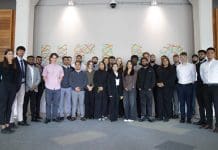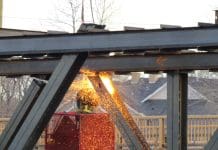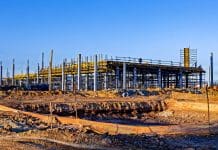In light of SCIA Engineer‘s new structural engineering software update – Irca Schepers, account manager at SCIA, interviewed Hilde Sevens, CEO at SCIA and Viktor Várkonyi, chief division officer at the Nemetschek Group about the trends and the future of the AEC industry and how SCIA responds to that evolution
First of all, Viktor, could you explain your function within the Nemetschek group?
Viktor: Yes of course, I’m the chief division officer of the Nemetschek Group. The Nemetschek Group is organised into 4 major divisions, addressing the specific needs of market verticals and I’m responsible for the design division, taking care of our customers who are on the design side of the AEC workflows.
So, we are highly focused on the BIM market and I’m personally engaged with this market for quite long as I joined my first company Graphisoft in 1992. And I’m in the industry ever since. It’s a fascinating market space so I’m pretty excited to be in this group. And obviously, my job is to take care of the global strategies and our brand that is spread all over the world. All in all to make sure that we stay at front of the industry.
Can you remember the first time you heard about the plans to revolutionise SCIA Engineer?
Viktor: Yes, I think it was about three years ago when we had a deep strategy discussion with Hilde and the management team of SCIA. That discussion was about – which I think is very important in the software industry – how you reinvent yourself from time to time to make sure that your technologies and your solutions are not ageing but you stay ahead of the competition.
I think what SCIA started three years ago is exactly addressing this need. To make sure that we deliver a very competitive solution to our customers.
And Hilde, what was your first impression of the new UI?
Hilde: Of course, I followed the new UI along the three years but I was thrilled, really thrilled with the fact that the whole UI is basically working in perfect harmony with the structural engineer and that was always the intention, the fact that we have built in a full workspace transformation to allow the engineer to have much more space to work in. The key point that I really get excited about is that this interface is not just easy to use and learn, it’s also fun to use and that really gets me excited.
Me too! Where do you think the new UI differs from the old one?
Hilde: It’s a little bit like what Viktor was saying. We really want to be ahead of the curb and if we look at the old UI, it is how all the structural engineering software is looking like today. And what we wanted to do is really bring about a revolution on user experience so we really focused on user experience and when you have a UI with a lot of features and functions, as you do with SCIA Engineer, it is easy that things get a little cluttered or what we sometimes heard from our customers was that we can’t find this or that function very easily and so we really focused on building an intuitive workspace and an intuitive way of finding things.
We have this feature called ‘spotlight’ which allows you to find anything in a split second and that really makes the environment intuitive and easy in use. So that’s one of the areas where we differ from before. And I really believe that it is a revolution in user experience in our field.
Yes, absolutely. Do you feel that UI has an impact or can contribute to raise productivity and ROI within the AEC market?
Viktor: Oh absolutely and I just want to emphasise that many people consider UI as a bunch of dialogs and menu items. In my opinion that’s somewhat different. The UI and UX have to go much deeper.
A modern and fresh UI always comes together with a modern and fresh software inside. So if there’s a mismatch, it immediately comes to the surface. You just cannot hide it. Just think about products that you use day by day. An iPhone for instance – it has a beautiful UI but it also has a lot of substance behind it, a modern technology, so you enjoy a lot of benefits. I would like to bring up three major aspects.
The first one is that our job is to make sure that our clients can focus on their job. Ultimately they have to deliver on the client requirements in terms of cost, functions and quality. If the software behaves as our user would assume, then that mission can be accomplished.
The user then can really focus on the job. And by doing that, the second aspect is that we can unleash creativity. Design is always about thinking. How the software supports the creative process is extremely important. If you always have to search for certain buttons, then you are not driving success. Of course, what Hilde already mentioned is that fun and enjoyment are always strongly linked with the user interface.
And ultimately, enjoyment in work brings a lot of motivation to our clients, which also leads to productivity so that our clients can attract the best people in the market. I could bring up some examples of how UI really delivers productivity and UI in different aspects.
Hilde, how do you think this will impact the day-to-day workflow of a structural engineer?
Hilde: I think it will affect it drastically, I think the efficiency will get a huge step forward. People will have an easier time to learn the software and use it in a day-to-day setting and, as Viktor mentioned too, the fun fact. Although it might sound like it’s not work-related but it is. If you have to work day in day out with one tool, then it’d better be fun to use it, right? I think that’s also going to enhance the efficiency and the creativity of the structural engineer, allowing the structural engineer to focus on the things that they like the best and they want to do the most of. I think it’s definitely going to be huge.
And Viktor, do you think we are changing the market of structural engineering software?
Viktor: Hopefully yes. You know that I’m not a structural engineer. But I’ve always been fascinated by all the new technologies that are coming year by year into our industry. If you just think about what kind of buildings we are designing today and have been designed a couple of years ago in terms of materials and shapes and forms, then the market around us is just extremely fast. There’s room for innovation.
With SCIA, I’m absolutely sure we’re ahead of the market and leading the transformation in the industry, unleashing innovation. I always say during business reviews and business discussions when people say that this is our competitive advantage, no, that’s not right, our competitive advantage is that we deliver a competitive advantage to our customers.
So ultimately, we have to innovate in a way that our customers can be the best on the market. This is the role of software: to make sure that our customers can be ahead of the industry and competition.
Of course. And as you said yourself, Viktor, the Nemetschek group has always been very innovative. Could you tell us a little bit about how you see the future?
Viktor: There are millions of trends out there on the market. Maybe I’ll just focus on one, because of the limited time. The world we live in is extremely fast and it’s getting faster and faster everyday so it’s absolutely critical how we can respond to the clients’ needs. And in most of the cases those needs are not constant so the projects are evolving, there are new ideas and we have to be very responsive for that.
First of all, we have to bring the professions closer to each other.
The Nemetschek group is quite innovative in the way that architects, structural engineers and engineers in other disciplines can join in one team. If you follow the announcements, you’ll hear about the great stuff that is created by the group. Archicad, Allplan and SCIA, for instance, are working on leading solutions. Just to mention the latest announcement from SCIA Autoconverter which I think really connects the structural engineering profession into the overall design flow.
Would you like to say something else to our customers?
Viktor: My message would be: don’t be afraid of change. Whenever you make a decision to change your processes, do it with full stamina. I’ve seen our customers being very successful with clear management decisions and afterwards a great execution.
Our market is so fast around us that it’s great to keep up with all the innovations around us and surely SCIA and the other businesses of the Nemetschek group can help you in this journey.
Irca: Thank you very much for the last question.
Hilde: I would like to add something too, if you don’t mind. I think change is hard – everybody has a hard time with changes. This is a huge change in our user experience, in our user interface, so I think it’s sometimes a little daunting for our customers but I am convinced that if they use it maybe one day a week or so that they would not want to go back to the old user experience and old user interface.
So when they do make the decision to move to V21 and I hope they all will very quickly, that they indeed go with stamina and just go for it and they’ll see that it’s very much in their benefit and they’ll all have a lot of fun with it.
Irca: I’m also convinced of that. And with that last question, we’re coming to the end of this interview. Hilde, Viktor, thank you very much for joining and sharing your insights with us.
Viktor Várkonyi
Chief division officer


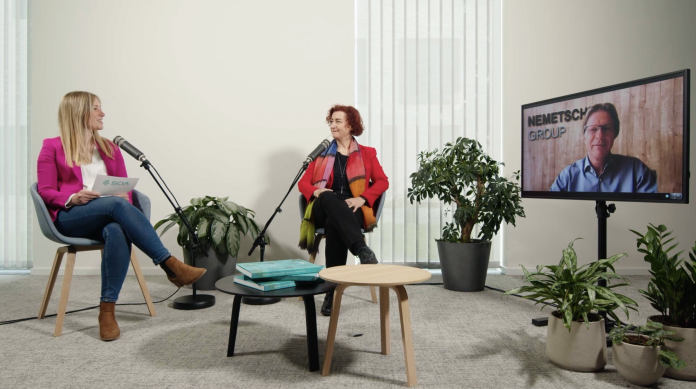


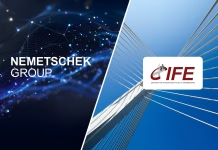
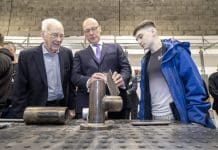
![[VIDEO] HS2 M6 viaduct slide completed early The HS2 M6 Viaduct on its sliding journey](https://www.pbctoday.co.uk/news/wp-content/uploads/2025/09/M6-viaduct-East-Deck-in-place-over-the-motorway-September-2025-218x150.jpg)



